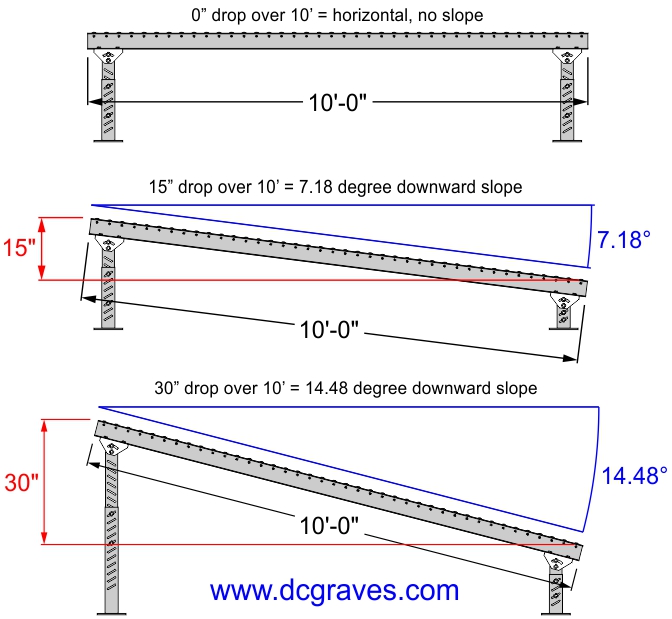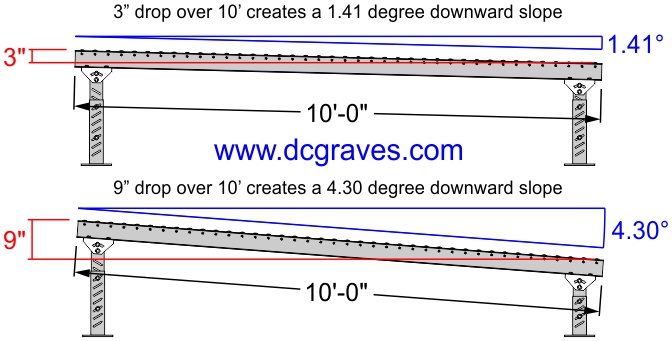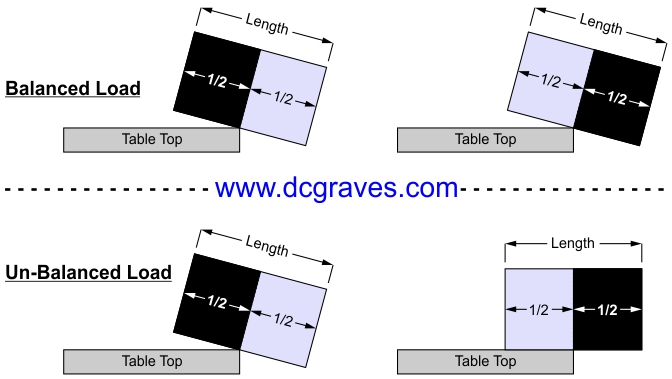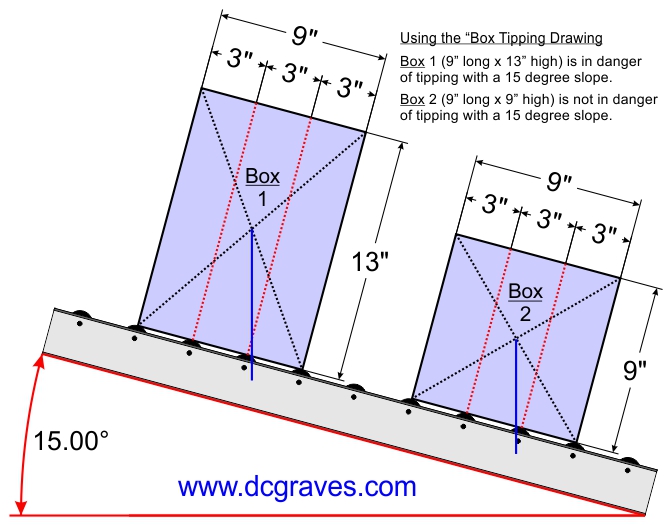|
Gravity conveyors from DC Graves are an ideal transportation system for moving boxes, packages, etc.… throughout your facility. With gravity industrial conveyor systems there are no need for electrical hook-ups as the packages being fed down the conveyor line are moved via gravity. The conveyor lines can be set-up with a slight decline or can be manually pushed down the conveyor. Conveyor sections come as standard in 5’ and 10’ lengths and can be cut to custom sizes. By linking multiple sections together you can create runs of various lengths.
|
Important Dimensions
|
|
When talking about gravity conveyors there are a variety of dimensions that you must be familiar with as they are all important.
|
|
Gravity Conveyor Basics
|
|
Rollability
|
|
For good rollability, the conveying surface (the bottom of the product that sits on the conveyor as it travels along the conveyor) should be rigid and flat.
|
|
Capacities
|
Gravity conveyors have three capacities, all three must be considered.
1) Roller capacity
2) Support capacity
3) Conveyor Frame Capacity, supports on 5’ centers, supports on 10’ centers
|
|
Special Length Pricing
|
As standard, gravity conveyor sections are priced and sold in 5’ and 10’ long sections. You can order special length conveyor sections. To price out a special length of conveyor use this formula.
Take the ten foot price of the gravity conveyor you are purchasing and divide that price by 10. This gives you the “price per foot”. Next round up the length of your special length conveyor. A 7’0” length would round up to 7’0”, and a 7’1” length would round up to 8’0”. Now simply multiply the rounded up special length by the “price per foot” and that is the price of your special length conveyor section.
|
|
Conveyor Supports
|
Industrial roller conveyor and skate wheel conveyor supports can be used to support individual lengths of conveyor and or they can be used in common when conveyors are joined together to create runs. To order the correct number of legs you need to know, how your gravity conveyor project will be set-up.

Above Gravity Conveyor set-up as two stand-alone sections.
Parts list for above (1) 10’ length conveyor (1) 5’ length conveyor (4) supports

Above Gravity Conveyor set-up as one run two sections long.
Parts list for above (1) 10’ length conveyor (1) 5’ length conveyor (3) supports
|
|
Conveyor Slope
|
Gravity conveyor can be set up with a slope for gravity flow, set up to take product discharged from one machine and deliver it to the intake of another machine or set up as horizontal with no slope for manual push/pull flow. It is important to know what your slope will be when specifying conveyor legs and in properly specifying conveyor roller centers. There is no set slope setting to choose from, the conveyor legs are infinitely adjustable within their own height range allowing any slope you might need. The conveyor slope can be limited by many factors such as the “Box Tipping Formula”, the working height range required, the working height range available or ergonomic considerations.

|
|
Gravity Flow Slope
|
For applications where you want to move product using the power of gravity, pre-determining the proper slope required is not easy. Especially when you have a large number of different products with different sizes, weights and conveying surface characteristics. We can offer guidelines, but most often, the actual slope is not determined until the day of installation. This can be quite troubling, for example, when dealing with long conveyor runs. Imagine if your plan calls for 100’ of gravity conveyor and you plan on a drop of 3” for every 10’, only to find that you actually require a drop of 9” for every 10’, your height difference from start to finish would go from 30” to 90”. It’s not a bad idea to order a 5’ length of conveyor in advance to verify the slope that will work for you.
Most gravity flow slopes will fall between a range of 3” to 9” of drop per 10’ of conveyor length. The 3" drop for heavy loads with rigid bottoms scaling to the 9" drop for light loads with softer bottoms.

|
|
Three Roller Minimum Method
|
As a minimum, there should be three rollers under your product at all times. This method assumes that your product has a balanced load. If your load is unbalanced, the “Three Roller Minimum Method” may not work, unbalanced loads require further consideration.
“Three Roller Method Minimum” Formula:
Roller Center x 3 = Smallest Box Length This Roller Center Can Handle.
|
|
Roller Centers
|
For Conveyor Series
|
Smallest Box Length Using
The Three Roller Minimum Method
|
|
1.5"
|
Series 10 Only
|
4.5"
|
|
2.25"
|
Series 20, 30, 40, 50 Only
|
6.75"
|
|
3"
|
Series 10 thru 80
|
9"
|
|
4"
|
Series 70, 80, 90
|
12"
|
|
4.5"
|
Series 10 thru 60
|
13.5" (see below)
|
|
6"
|
All Series
|
18"
|
|
8"
|
Series 90 Only
|
24"
|
|
9"
|
Series 10 thru 80
|
27"
|
|
12"
|
All Series
|
36"
|

|
|
Identifying Unbalanced Loads
|
Loads that are unbalanced must be identified. A simple test that can be performed on your boxes is the “Edge of Table Test”. On any level table, cabinet, workbench etc. extend exactly ½ of the box length off the edge of your table, then rotate the box 180 degrees (without lifting the box) and extend the other end of the box, exactly ½ of the box length, off the edge. If the box wants to tip from both ends of the box, it is balanced. If one side wants to tip and the other side does not tip than the box is unbalanced. Identify all unbalanced boxes and set them aside for further testing.
"Edge of Table Test"

|
|
Box Tipping Drawing / Box Tipping Ratio - Methods
|
Box Tipping Drawing

You can check whether any box will tip by creating a diagram to scale using these guidelines.
1) Draw box size.
2) Divide length of box into thirds and draw lines (red dotted lines).
3) Draw diagonal lines corner to corner to find center (black dotted lines).
4) Rotate box and all lines to match the conveyor slope.
5) Draw vertical line straight down from the center of the box through the bottom of the box (blue solid line).
6) If the blue line falls outside of the red lines as it passes through the bottom of the box the box will not work with this slope (box 1).
7) If the blue line falls within the red lines as it passes through the bottom of the box than it will not tip with this slope (box 2).
Box Tipping Ratio
This is another method to check for box tipping that is based on the box length to box height ratio. This method does not involve any drawing.
1) Divide the length of the box by the height of the box, this will give you the “Box Ratio”.
2) Check the “Box Tipping Ratio” Chart below, find the highest “Box Tipping Ratio” that is lower than your boxes “Box Ratio” and your box will work with that slope or any slope that is less.
|
|
Box Tipping Ratio - Chart
|
|
Slope
|
Box Tipping Ratio
|
Slope
|
Box Tipping Ratio
|
|
30 Degree
|
1.7320
|
19 Degree
|
1.0329
|
|
29 Degree
|
1.6629
|
18 Degree
|
.97475
|
|
28 Degree
|
1.5951
|
17 Degree
|
0.9172
|
|
27 Degree
|
1.5285
|
16 Degree
|
0.8602
|
|
26 Degree
|
1.4632
|
15 Degree
|
0.8038
|
|
25 Degree
|
1.3989
|
14 Degree
|
0.7479
|
|
24 Degree
|
1.3356
|
13 Degree
|
0.6926
|
|
23 Degree
|
1.2734
|
12 Degree
|
0.6376
|
|
22 Degree
|
1.2120
|
11 Degree
|
0.5831
|
|
21 Degree
|
1.1516
|
10 Degree
|
0.5289
|
|
20 Degree
|
1.0919
|
9 Degree
|
0.4751
|
Using the example from the Box Tipping Drawing above:
Box 1: 9” long divided by 13” high = .6923, using the Box Tipping Ratio chart above this box would work with a slope of thirteen degrees or less.
Box 2: 9” long divided by 9” high = 1.000, using the Box Tipping Ratio chart above this box would work with a slope of eighteen degrees or less.
|
Steel Roller Conveyor: these gravity conveyor systems utilize steel rollers attached to a steel frame to convey your product down the line. We offer rollers in diameters from 1-3/8” up to 3.5”. These varying diameter rollers offer a great range of capacities facilitating the movement of light and heavy products. The rollers can be configured on 1.5”, 3”, 4.5”, 6”, 9”, and 12” centers depending on the weight and length of your product. Please call to discuss the correct configuration for your application.
Aluminum Roller Conveyor: similar to steel roller conveyor but made with aluminum rollers and frames. This series of conveyor is perfect for light duty applications and suited well to wet areas as the aluminum construction is more resistant to rust than the steel conveyor.
Steel Skatewheel Conveyor: are perfect for light-weight applications that can constantly change. DC Graves offers zinc plated steel wheels with a 1-15/16” diameter and 5/8” face. The lightweight nature of skate wheel conveyor allows the user to move their conveyors easily to adapt to changing conditions. Skate wheel conveyor is perfect for unloading trucks.
Aluminum Skatewheel Conveyor: offers the same advantages of the steel models but weigh even less making moving your conveyor even easier. Like the aluminum roller conveyor, our aluminum skatewheel conveyors handles wet and humid conditions better than the steel.
|